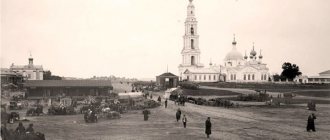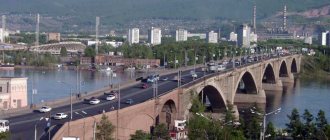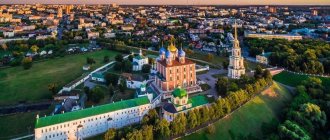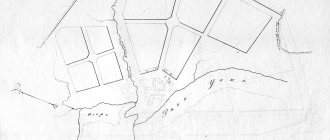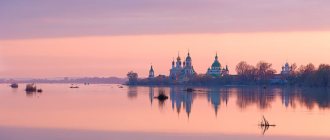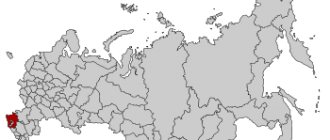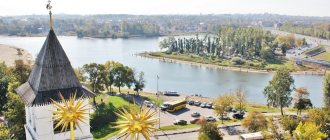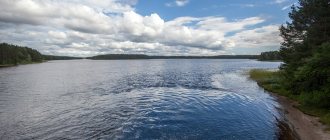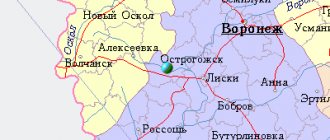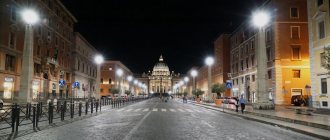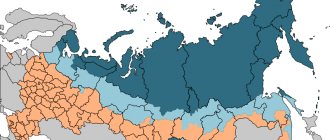Gray sky, gray snow, gray gloom in the air... “The holiday is coming to us, the holiday is coming to us...” - booming in the headphones. “Yes, the holiday... It’s coming...” I mutter grayly in his tone. The off-season is a difficult time. This February morning, getting into the car, I tried to awaken in myself the right feeling of the upcoming holiday: the long weekend has arrived, which means there is no need to waste time and it’s time to go on another short trip. Today we are going to the city of Kalyazin, Tver region. Oh, just don’t tell me before going on the road that there’s nothing to see there, that all the best in it has long since sunk to the bottom of the Volga reservoir. We'll see for ourselves and form our own judgement. At that moment, the rays of the sun broke through the grayness and added color to the world, and we set off on our way.
There is such a city
Do you know, friends, that foreigners who come to Russia, almost eighty percent of them, come for tours around the cities of the Golden Ring? How many of us Russians can boast that we were there too, that we saw all its wonderful cities? Alas, we are just one of those who, on our vacation, traveled not so much throughout Russia as abroad; we are those who have not seen all the cities of the Golden Ring.
It’s time to fix this, we decided, and chose the capital of the ring, Yaroslavl, as the goal of our next trip.
It’s easiest for motorists - it’s 270 kilometers away by car along the Yaroslavskoye Highway. And along the way there are many towns with wonderful Russian names - Kimry, Borovsk, Kashin, Uglich, Myshkin, Kalyazin... Don’t drive past them with indifference!
It's decided - we'll go. Of course, not all of them, but only three - Kalyazin, Myshkin and Uglich, where we will spend the night. But here a bummer awaited us: we were unable to book a place in any of the Uglich hotels. However, this was a minor problem: in the trunk there are sleeping bags, webast and other joys of automobile tourism :).
The sun strokes the trunk of our car with bright rays - a Toyota named Dambik, kilometers joyfully rush under its wheels, fields, forests and ravines, exits and turns fly by. We turn right from Yaroslavka, then left, in an hour we will be in Kalyazin!
Sights of the city of Kalyazin
Let's take a quick look at the main attractions
, which you can see in Kalyazin. You can read more about them on the corresponding pages of our website.
Sights of Kalyazin
How to get to Kalyazin by car?
By any of two routes:
- Along the Dmitrovskoye Highway to the city of Dmitrov, from there to Taldom. At Zhestylevo, pay attention - here you turn left, since the A108 going straight will take you back to Sergiev Posad. From Taldom to the village of Kvashenki, turn right. We drive to Spas-Ugol, where the road turns sharply. Continue to the Nerl and exit onto P104. From here it’s a stone’s throw to Kalyazin—about twenty kilometers.
- For us, another route is geographically more convenient: along the Yaroslavskoe highway through Sergiev Posad and immediately along P104. Although, however, you can go around Posad itself, and at the intersection of the bypass with the Great Moscow Ring, turn left and get to P104 and to Kalyazin.
Eh, Russian roads, seven bends per mile... We are driving the same road along which we were supposed to move to Vottovaara together with the Crocodile. The further from the capital, the worse the path gets. In the Tver region, in some places it shakes well on bumps and holes, but we also drove on really much worse roads. So we think it’s normal, you can drive!
Funny name Zhabnya
And here comes the Volga. Ha, the mistake is not the Volga yet, but only its tributary - the Zhabnya River. Who could tell why she was given such a frog nickname? Or did it come from the buttercup-like medicinal plant toadwort?
There are cars along the shore selling fish. We stop and ask the price. And oats, that is, the catch, is not cheap these days: a small roach costs 100 rubles, a small smoked greenling costs 200 rubles... I sighed sadly - on the Western Dvina for that kind of money they bought such a huge fish.
History of Kalyazin
We turned away from the fish again to the Zhabna River. Chronicles say that at the place where it flows into Mother Volga, where the St. Nicholas Bell Tower now stands, at the end of the 12th century there was a monastery in honor of St. Nicholas the Wonderworker.
We already had occasion to discuss what monasteries were in that distant time and what functions they performed. Yes, of course, there were monks and services there, but this was only one aspect of their activity; it is also important that the monasteries were fortresses, that is, military strongholds. Under their protection, people settled nearby and settlements grew. This is how the settlement of Nikola-na-Zhabnya arose.
But little has reached us about the first of the eight centuries of Kalyazin's history. As for the Nikolsky Monastery, over time it lost its significance and ceased to exist. But in its place there was always a church with the same name. Years, fire, or raids destroyed it, but the inhabitants invariably restored it. And in the 18th century, St. Nicholas Cathedral was rebuilt in its place, which became the adornment of the entire Tver land.
About the area
K alyazinsky district
| Administrative center: Kalyazin Geographical location: Kalyazinsky district is located in the south-eastern part of the Tver region, 180 km from Tver and 176 km from Moscow on the banks of the Volga River. The area borders on the Yaroslavl and Moscow regions. The administrative center is Kalyazin. Territory of the district: 1671 sq. km. |
Population: The population of the Kalyazinsky district according to the 2010 population census was 21,688 people. In terms of population, the district ranks 13th among the municipal districts of the region. Most of the region's population of 13.9 thousand people live in the city of Kalyazin, in rural settlements - 7.8 thousand people. There are 330 villages and villages located on the territory of the district, of which two are large, with a population of 500 people or more. In 118 rural settlements of the region, from 6 to 25 people live; 101 rural settlements are home to 1 to 5 people; 57 rural settlements in the region are empty.
Transport infrastructure: the area has an advantageous geographical location, which makes it possible to use all types of transport:
• railway connections with the cities of Moscow, St. Petersburg, Yaroslavl, Uglich, Rybinsk; • highways “Moscow-Tver”, “Moscow-Cherepovets”; • waterway along the Volga River.
Historical information: Kalyazin stands on the banks of the Volga River. Cargo, passenger and tourist ships sail past the city of Kalyazin to Moscow along the Volga-Baltic Waterway, which unites the internal river routes of the European part of Russia into a single system and connects the Baltic, White, Caspian, Azov and Black Seas. Almost all types of transport connect the Kalyazinsky district with Moscow. The Volga River flows through the region for 56 km.
Kalyazin is one of the ancient cities of the Tver land. The first known settlement mentioned in one of the Russian chronicles on the site of modern Kalyazin was called “Nikola on Zhabnya”. It was located at the mouth of the Zhabnya River. In the 15th century, the Makaryev Monastery was founded on the left bank of the Volga, known as the Trinity Kalyazinsky first-class monastery, which became the adornment of the city, the center of its economic and spiritual life. He enjoyed the blessing of the reigning persons, as well as the appanage princes of Tver and Moscow, and always served the fatherland with his wealth. During the “time of troubles”, Polish conquerors crossed the Kalyazin land twice. In 1609, they plundered and burned Nikolskaya Sloboda and the village of Pirogovo. The following year the monastery was plundered. Rebuilt again in 1633-1654, the Kalyazin Monastery shone with its beauty and splendor for a long time.
The construction of the Uglich reservoir decided the fate of the monastery. In 1936-1940 it was dismantled and flooded along with the old part of the city. The reservoir swallowed up 2/3 of Kalyazin, 4 dozen settlements of the Kalyazin region. The historical part of Kalyazin, its pearl Trinity Monastery, St. Nicholas Cathedral and much more went under water forever. Standing in the middle of the water is one of the most beautiful bell towers in the Upper Volga region. During the Great Patriotic War, more than 14 thousand Kalyazin residents fought on various fronts. Six of them became heroes of the Soviet Union.
In the mid-12th century, various trades and crafts developed in Kalyazin and its environs: blacksmithing, pottery, shoemaking, felting, tailoring, lacemaking and others. Kalyazin was famous for its woven lace. Kalyazin lace went to St. Petersburg, Moscow, and abroad.
The Kalyazinsky district was formed in 1929, it was part of the Moscow region, and since 1935 it was part of the Kalinin region. By 1934, complete collectivization of agriculture was carried out. In 1963, the Kalyazinsky district was annexed to the Kimry district and restored in 1964.
Kalyazinsky district was visited by A. S. Pushkin (the Ushakov estate in the village of Nikitsky), comedian D. I. Fonvizin, poet V. A. Zhukovsky, teacher K. Ushinsky, artist N. K. Roerich, and many Soviet writers. Actress M. N. Ermolova lived here for a long time. V. I. Kachalov, I. M. Moskvin, T. L. Shchepkina-Kupernik visited her. In the village of Voskresensky, the famous mathematician, astronomer, theater critic and writer S. A. Yuryev was born, who created a folk theater and a school for peasant children. The writer M.I. Volkov was born in the village of Sknyatino. In 1858, Alexander Dumas stayed in the village of Elpatievo on the estate of Princess Naryshkina during a trip to Russia.
Water resources: rivers Volga, Nerl, Zhabnya, Vyulka. The area of the lakes is 2332 hectares. Peat reserves – 13 million cubic meters. 43% of the region's territory is covered with forests, of which 57% are coniferous, 43% are deciduous. The area also has large reserves of clay suitable for making bricks and ceramics. River sand is extracted from the bottom of the Volga River. Fish resources are the main basis for the development of a fish processing enterprise.
About the development of the Kalyazinsky district 2016-2017.doc
Statistics 2022
Macarius of Kalyazinsky and the monastery he founded
The Monk Macarius of Kalyazin is now little known. Meanwhile, for our ancestors this was a very significant saint. As you know, in the Orthodox Church there are locally revered saints, revered within a particular diocese or parish, and there are saints revered by the entire Russian Church. Macarius was canonized as an all-Russian saint.
A little about him. In 1400, at the turn of the century, a boy named Matvey was born into a boyar family that lived in the village of Kozhino, not far from Kashino. When he grew up, he began to ask his parents for blessings to take tonsure. But those blessings were not given - after all, their eldest son had already accepted monasticism.
Matvey's parents found a bride - a boyar's daughter - and soon married him. And the young couple had three whole years of family happiness, until the pestilence came here.
21-year-old Matvey is widowed. The misfortune strengthened his desire to withdraw from the world. He took monastic vows and became Macarius.
After some time he went to an empty place. I found this near the ancient town of Nikola-on-Zhabny, just on the opposite bank of the Volga. He built a temple in a wild forest and consecrated it in the name of the Life-Giving Trinity. But the trouble is: Macarius was mistaken, the place turned out to be not empty and had an owner - the local boyar Ivan Kolyaga.
Fearing for the fate of his possessions, the boyar planned an evil deed - to kill Macarius. But immediately after the plan, all sorts of problems and illnesses rained down on him and his loved ones. An intelligent man, Kolyaga quickly figured out the cause of his troubles. He was ashamed, deeply repented and asked Macarius for forgiveness. He forgave the would-be criminal and even pitied him. And Kolyaga was reborn after that.
After some time, boyar Ivan recovered, and having recovered, he took monastic vows. And the wise Macarius, for the edification of his descendants, added the word Kolyazin to the name of the monastery - Trinity Monastery. So that we know: the nature of people is imperfect, they can think, and even act unseemly. But! But if you repent in time, then both the life of the sinner himself and the life of his loved ones will take a different path - good and correct.
Over time, the Kolyazina settlement grew near the monastery, and then this name united three settlements - Makaryevskaya, Nikolskaya and Zarechnaya, separated by rivers. In 1775, it was given the status of a county town and given the name Kalyazin.
And the monastery became the center of the religious, cultural, and political life of these places for a long time.
Saint Macarius and his monastery
Kalyazin Trinity Makaryev Monastery
The city is rich in legends and traditions. Monastery of St. Nicholas on Zhabnya fell into oblivion long before Kalyazin was awarded city status. But in the middle of the 15th century it stood - and on the opposite, left bank of the not yet so wide Volga, the monk of the Kashin Klobukov Monastery, Macarius, settled, who founded a monastery in the name of the Holy Trinity. According to legend, the land for the monastery was donated by local nobleman Ivan Kalyaga, otherwise Kalyaz, of course, without imagining that he was thereby giving a name to the future city. This happened in 1434, and from here the Kalyazin chronology begins.
There are, of course, other versions of the origin of the name: some associate it with the Finno-Ugric word “kola” - fish, or with the Finnish “kalyaasi” - sailboat, others - with the Russian “kolo”, meaning circle. Rearrangements and replacements of vowels and consonants in Russian names and titles are not uncommon, and the city was sometimes written as “Kolyazin”. A similar story happened with Ksnyatin - this name most likely occurred as a result of a distortion of the name “Konstantin”, which was not changed in Rus', but the village standing in its place - Sknyatino - was more convenient to pronounce.
Iconographic image of St. Macarius Kalyazinsky
Little is known about Macarius Kalyazinsky: in the world he was called boyar Matvey Vasilyevich Kozhin; Having buried his wife, he took monastic vows and went to look for a place for solitary prayers on the wooded banks of the Volga. Some sources say that Kalyaga, having lost his family, became one of the monks of the Trinity Monastery, donating everything movable and immovable here. In others, the landowner allegedly plotted evil against Macarius, but, having fallen ill, he repented, asked for forgiveness and began to help the monastery.
Bishop Gennady of Tver was Macarius’s younger brother, and Paisiy of Uglich was his nephew. There are legends about the origin of the Kozhins, disputed by historians, related to their exit from Lithuania, or even Sweden, and their valiant service to the Moscow princes - however, no one questions the loyalty and courage of the ancestors of the Kalyazin saint.
Together with Macarius, seven more Monkmen came to the Volga bank and in forty days they cut down the cells and the wooden Trinity Church. On the other side of the river, next to the St. Nicholas Monastery on Zhabny, there already existed a small settlement of Pirogovo and fortifications, mentioned in the chronicles of 1339 as “Svyatoslavl Field”. From the first days, Macarius, whose modesty was more than once noted by his contemporaries, refused to become an abbot and eventually accepted this rank only in order to restore order among the growing brethren. This order was praised by Joseph Volotsky, who visited the monastery, and it was not easy to earn the praise of such a zealous and strict clergyman.
Monument to St. Macarius on Karl Marx Street (Moskovskaya)
Macarius dressed more than modestly; others laughed at him, to which he did not pay attention. He worked not just equally with everyone else, but more than others, healed the sick and possessed, and in hungry years he often distributed his bread to others and the poor. While strengthening the monastery, he transferred to it the lands he had inherited, and to them were added possessions donated by others, exchanged or acquired with donations. Great princes and boyars came to ask for blessings from the humble abbot, and once, on the way to distant India, Afanasy Nikitin knelt before Macarius, which he mentioned in his “Walk across the Three Seas.”
The abbot died in March 1483, and in 1521 his relics were found incorrupt, after which he was canonized as a locally revered saint, and in 1547, under Ivan the Terrible, he was canonized as an all-Russian saint.
The Terrible Tsar visited the Trinity Makarievsky Monastery twice; Boris Godunov visited the monastery and ordered a silver shrine for the relics of St. Macaria. In 1654, the entire family of Alexei Mikhailovich and Patriarch Nikon took refuge here from the epidemic. Peter led amusing regiments to Kalyazin, Catherine the Great and the future heirs to the throne, Alexander II and Alexander III, came to Kalyazin.
It was one of the most famous and famous Russian monasteries; It was not for nothing that in Catherine’s times it was considered one of the first-class, and the Empress herself, who was strict with the monks, donated 50 gold pieces to the monastery.
Monument to Prince M.V. Skopin-Shuisky at the Ascension Church
During the Time of Troubles, Prince Skopin-Shuisky defeated the Polish invaders near the walls of the monastery. A year later, the foreigners who had gained strength took the monastery by storm, plundered and burned, and killed the brethren and other defenders. The silver shrine of Macarius was cut into pieces and dragged away. Only the stone Trinity Church (1521) and the Boris and Gleb Church (1530) survived the fire. With the restoration of the monastery, they were supplemented by the fraternal, abbot's and viceroyal buildings, as well as the Assumption, Alekseevskaya and gatehouses, dedicated to St. Macarius, church. Construction artel led by Mark and Ivan Sharutin in 1644-1648. erected reliable walls with towers. The walls of the Trinity Cathedral were painted by 17 icon painters.
Modern panorama of the city
It became the way we see it relatively recently - by the middle of the 19th century. By this time, there were approximately 1,200 houses, 7 churches, a monastery, an embankment, piers, and 33 factories. This is what it says on the city's official website.
If you believe the statistics, then even now life here is in full swing - four schools, seven pharmacies, restaurants, hotels, there is even a yacht club, there are two operating churches in the city and there are even working enterprises. This is a garment factory for sewing work clothes, a creamery, a couple of small flax factories, and the felt felt factory, famous throughout Russia. But there are rumors that it will be closed soon.
Kalyazin is a small city, only 15 thousand people live in it. You can get around it in a couple of hours. And although it is located very close to Moscow, it is nevertheless a real Russian outback.
Life here moves slowly, roosters crow in the mornings, dogs run freely. In the summer, the roadsides are probably overgrown with tall grass and burdocks, maybe even boys are running barefoot... On the streets, like a hundred years ago, there are water pumps, people with buckets, houses with stove heating. And now there was a little haze in the city air...
What's left?
Ascension Church
The Church of the Ascension, built in 1783, belonged to the parish of St. Nicholas Cathedral. The single-domed quadrangle under a baroque dome is connected to the classical three-tier bell tower by a refectory, completed with a gable pediment, decorated in the Gothic style, and a multi-pitched roof. It is interesting that the eclectic refectory is twice as wide as the corresponding dimensions of the temple and bell tower, which is unusual for churches built by a “ship”. In addition to the main, Ascension throne, the temple has two chapels, Macarius of Kalyazin and the Tikhvin Icon of the Mother of God; in the middle of the 19th century The Assumption throne appeared. In the 1930s, the temple was given to a local sports club, and football was played in the churchyard, and just before the flooding, it was given to a bakery. Then it was abandoned and only in the 1990s was returned to believers, and in a very deplorable state. The restoration of the temple was undertaken by the parishioners, led by Archpriest Leonid Beresnev. Nowadays services are held here, and parish life flows smoothly. At the entrance to the temple in 2009, a monument was erected in honor of the victory of the Skopin-Shuisky militia, won 400 years ago over foreign invaders, and in 2012 the relics of St. Macarius of Kalyazinsky - they rested in the chapel dedicated to him.
House of merchants Ryzhkov
On Moskovskaya Street there are remains of buildings typical of a merchant town. On weekends, here, on the descent to the unflooded bell tower, souvenirs are sold, and on special days, festive events are held and creative groups perform.
City Hall building
The building of the former zemstvo government is occupied by a school, and before the revolution, in addition to the school, it also housed the gendarmerie and police department.
Snow-white mansion of the Korovkins
The descent to the Volga is lined with merchant mansions of the 19th century, not similar to each other. Here, in a small area, you can admire the delights of architects who turned to the order tradition of classicism (the Korovkin house with triangular pediments and pilasters cut with flutes), the Renaissance (the Lyakhov house, decorated with a diamond rustication on the frieze), and Baroque (the volutes of the pediment of the Ryzhkov house).
House of Lyakhovs
The Obukhov brothers owned a candle production. The Ryzhkovs traded in textiles in Kalyazin, Kimry and surrounding villages. The Shishkins owned an iconostasis workshop, which grew into a large factory - these iconostases were famous throughout Russia and took prizes at international exhibitions. The most wealthy were the merchants of the 1st guild, the Polezhaevs - they were engaged in the grain trade, opened a technical school in their house and did many other good deeds, and therefore the residents of Kalyazin entrusted the post of mayor to several representatives of this family in different years. Together with Alexandrovsk entrepreneur I. A. Pervushin, the Polezhaev brothers became the founders of the large Volga-Kama commercial bank, which ranked sixth among commercial banks in the Russian Empire.
House of Polezhaevs
The merchant Korovkin was also elected mayor. In addition to real estate, he owned a starch factory. Starch production for Kalyazin is just as traditional; It is interesting that this product, wet in the warehouse due to leaks or floods, was processed into powder and sold to the capitals.
Nevertheless, the Kalyazin merchants gravitated more towards classical architecture, apparently having admired the noble estates of the beginning of the same century - and such buildings dominate the development of the street. In the district, by the way, the estates were owned by the Saltykovs (the family of the great Russian writer M.E. Saltykov-Shchedrin), the Yuryevs, the Fonvizins, the Ushakovs - among the latter is Vasily Ushakov, on whose order the bell tower, which has become a sad symbol of the city, was built.
One of the most beautiful public buildings in the surviving part of Kalyazin is the Kalyazin Mechanical Engineering College, now a college. It was built in 1905 for the Lower Mechanical and Technical School, which was named after its benefactor - N. M. Polezhaev. Before his death, the merchant bequeathed 350 thousand rubles to the city (in those years a horse cost ten). They allocated 200 thousand for the school, purchased the necessary equipment, and invited good teachers. They accepted the children of ordinary citizens, taught them for free, and even paid them scholarships. Graduates became qualified craftsmen, fitters, and technicians in factories, shipping companies, and railway workshops. In one of the novels, the modern Tver writer A.V. Dostavalov, having hidden the heroes of the work in Kalyazin, noticed that the townspeople were proud of the Technical School, as rarely in any regional center - of their university.
Kalyazin Mechanical Engineering College, now - College
In the architecture of the impressive red-brick building, decorated in the Russian style, three risalits stand out, as if taken from classic estate designs: the side ones, with two-horned pinnacles, and the central one, with an additional floor under a hipped roof - epancha. The two-story U-shaped building, the design of which was drawn up by academician of architecture R. Marfeld, was built under the direction of engineer N. Nikitin from red brick on a white stone base.
Ascension Church, monuments to Skopin-Shuisky, as well as fallen heroes of the First World War and victims of the Red Terror - on Friedrich Engels Street
The college is located on Lenin Street, former Tverskaya, opposite Victory Park. During the years of Soviet power, great changes occurred in urban toponymy. Voznesenskaya street, named after the Church of the Ascension, received the name of Friedrich Engels, Svistushenskaya - Karl Liebknecht, Sergievskaya - Trotsky, then Kalinin, Spasskaya - Turgenev, Troitskaya - Uritsky, Bazarnaya became Sovetskaya, Zavolzhskaya embankment was renamed Vagzhanova street, and the place where The Epiphany Church rises above the river, called Nogin Square - this prominent Bolshevik and the first People's Commissar for Industry and Trade studied in Kalyazin.
Victory Park
But Comintern Street bore its name originally. It became the main highway of the new development, the plan of which was approved in 1939. Kalyazin retained the status of a city and, having lost 2/3 of its former territory, was allocated the lands of three collective farms, the village of Stepanovo and a timber mill site. Not only architectural monuments, including temple ensembles and many stone merchant houses, but also all industrial enterprises of the city (nine) found themselves in the flood zone. More than five hundred stone and wooden buildings were subject to transfer, including private houses, public utility buildings and, of course, industrial buildings.
Shekhonsky Mansion
Zarechye, the trans-river part of the city on the high bank of Zhabnya, introduces the traveler to other architectural and historical sights of the ancient city. On Vagzhanova Street, a small one-story mansion of representatives of the ancient family of Yaroslavl princes Shekhonsky, with garlands, pilasters, half-columns and other elements of baroque-classical decor, has been preserved.
Vvedenskaya Church
Another significant monument is the zemstvo hospital on nearby Turgenev Street (1867), built in imitation of the Romanesque style. Not a city, but a guide to architectural forms.
Zemstvo hospital building
Not far away, on Polevaya Street, there is the elegant tented Vvedenskaya Church (1882) with a hipped bell tower. Its ensemble, including the fence with the Holy Gates, is in excellent condition. The tented churches of the 19th century, of course, differ markedly from their predecessors from the times of the last Rurikovichs and the first Romanovs. Their tents do not rise so high to the sky; they are lower, but no less solemn. And here in the decor we see kokoshnik belts and profiled friezes.
How we see him now
“Where should we turn?” - Sanya asks me. Where... On the street going down to the Volga, there are a lot of tightly parked tourist buses and cars. Finally, there was a place for us - right behind the bronze monument to Macarius. Behind the saint is a plain under a snowy gray-lilac blanket - a frozen reservoir and a bell tower. A stream of people streams past the “No Trespassing on Ice” sign.
It once stood on the high bank of the river in the very center of the city. It's hard to believe - but it's true. The bell tower belonged to the central St. Nicholas (Nicholas) Cathedral of the 18th century, of which nothing remains.
Nearby there were noisy shopping arcades, roads ran from the market square and on the streets there were a huge number of merchant mansions - by the end of the 19th century there were a little more than two hundred of them in the city - beautiful, two-story, stone. And opposite stood the extraordinary beauty of the Trinity Makarievsky Monastery.
Near the monument, a small parody of an ancient trading square, there is a market with Kalyazin’s tourist goods: scarves, clay crafts, jars of honey, souvenir plates, magnets, books, dolls and other rubbish that travelers are so greedy for. Whether it’s a plate or a magnet, everyone will buy something and take it away as a souvenir.
We walked around, took a closer look, and asked the price, especially for honey, which Sanya is a big hunter and lover of. We walk, but don’t lose sight of the bell tower.
The Legend of the Guardian Elder
Kalyazin is a city simply filled with an ancient understanding of spirituality. Many churches, the Trinity Monastery, which now does not exist, because it was flooded during the creation of the Uglich reservoir, but for a long time was the center of the entire settlement and its heart, legends and the naive and pure faith in them of the Kalyazin people themselves. Just look at the legend about the treasures of the monastery on the Zhabna River.
It tells that during the Mongol-Tatar yoke there was a monastery on the Zhabna River, which had great treasures. The ascetics hid the monastery property among the swamps from the Tatar invasion, leaving the elder to guard it. The monastery was burned by the Tatars, and the ascetics were tortured in an attempt to find out where the monastic goods were hidden, but not a single one confessed. To this day, the elder, without dying, sleeps peacefully, invisible to people, but when trying to find and plunder the property of the monastery, he threatens with a staff and punishes with terrible punishments.
Each church in Kalyazin is beautiful in its own way, but they all evoke a feeling of spiritual uplift and seem filled with light. While in the city, it is worth seeing at least some of them.
Do you know any interesting regional expressions?
We stopped near a female tour guide waiting for her group. Sanya asks her: “Are the rest of the monastery buildings visible in the summer? Or just this one bell tower? Many people write that when there is a lot of shallowing, domes come out from under the water and walls appear?”
“No, all this is fantasy,” the sweet woman answers us, “There is nothing left except the bell tower. But the kids, diving, no, no, find at the bottom either a coin or a cross...” And at parting she suggested: “Make a wish and touch the wall of the bell tower - it will definitely come true...”
What a find! Thank you! TOUCH! Komsomolskaya Pravda collects such unusual local colloquial words in its dictionary of travelers around Russia. Let's give it to her - “touch it”!
Flooded Kalyazin
Karl Marx Street was once called Moskovskaya: the ancestors of Kalyazin residents were not clever with the names - they gave it away from the direction to Moscow. Lined with huge, centuries-old cobblestones, it led travelers straight to the city center.
It still leads, but to the center of the Uglich reservoir. Eighty years ago, almost the entire city, more precisely, two-thirds of Kalyazin with its entire historical center was flooded.
Flooding is a sad page in the life of this city. On the Volga alone there were 6 of his brothers in misfortune: Mologa, Puchezh, Korcheva, Vesyegonsk, Stavropol, Kuibyshev were flooded. But Kalyazin is the most famous among them.
In 1935–1940, the country had many ambitious plans. And below the city of Kalyazin they are building a dam designed to solve several problems. Firstly, to make Moscow a port of five seas, secondly, to make the Volga above Kalyazin well navigable and, thirdly, the most important thing: the leading word of technical thought of those times - the Uglich hydroelectric power station - will generate the cheap electricity the country needs. Against the backdrop of the upcoming grandiose tasks, the fate of the small town was of little interest to anyone.
And so in 1937 they began “dismantling” the old city with bulldozers and explosions. Little remains of its former splendor. The city stretched along the Volga, so it is not surprising that the most beautiful and historically significant buildings gravitated towards the Volga and were the first to fall under the flood zone. The remains of the merciless destruction were either transported to the wasteland where the modern part of Kalyazin now stands, or they were sent on barges along the Volga to Uglich.
Although there were some plans to build a city in a new place, they were not destined to come true. The Great Patriotic War interfered. After the war, other cities that fell into the zone of fascist occupation were restored, and more or less systematic construction in Kalyazin began only in the mid-70s.
They didn’t build masterpieces, of course, but rather standard, indistinguishable five-story buildings, so the soul of the city remained in small, crooked and quiet streets lined with one- and two-story wooden houses with flowers, currant bushes, apple trees and vegetable gardens.
The civil architecture of Kalyazin does not lag behind the temple
There is also something to look at if you are passing through the city or on purpose.
There are several particularly famous and beautiful houses and estates that will be interesting to see:
• Houses of the Korovkin merchants;
• House of merchants Ryzhkov;
• House of Merchants Lyakhovs (Women's Gymnasium);
• House of the Obukhov brothers;
• House of the Nogins;
• City mansion.
In the nineteenth century, the most beautiful mansions were built in Kalyazin - the houses of the Korovkin merchants, located on K. Marx Street. To this day, these buildings are some of the most interesting in the city. House number 5 - built in the first half of the 19th century, with three high semicircular windows and a triangular pediment above them - is memorable at first glance, and opposite house number 8 - the second half of the 19th century. Individual architecture gives them a special charm.
The house of the merchants Ryzhkov, like Chekhov's - a house with a mezzanine, was also built in the first half of the nineteenth century. The Ryzhkov brothers were engaged in the sale of textiles and had considerable capital, which allowed them to create this masterpiece with the symmetry characteristic of classicism with the hands of craftsmen.
On Karl Marx Street, on the corner (formerly Moskovskaya), there is a house of the Lyakhov merchants, which was built at the same time as the first two architectural monuments. It was built as a residential building, but later the building was purchased by the city and occupied by the City Duma. In 1908, a women's gymnasium was located there. However, to this day, “the sciences feed young men” there - the Kalyazin Pedagogical School is located in the building.
In Kalyazin there are two buildings that are similar in mezzanines and some other architectural details - this is a residential building and a candle factory of the Obukhov brothers. They are located at the intersection of Karl Marx and Lenin Street. Until 1929, the brothers' candle production was located in a one-story building. Now there is a souvenir shop here.
The Nogins' house was the property of the parents of the revolutionary Nogin, after whom many streets and squares in different cities were named. Located on Lunacharsky Street.
Unlike all of the above houses, the Town Mansion was built in the eighteenth century. This is one of the oldest buildings in Kalyazin. The strict lines of its architecture and discreet finishing details have the grace of modesty.
Bell tower in Kalyazin
There is no sun again, but in the huge open space there is no wind either, and this is a big plus. We just reached the bell tower, and most of the people, having flown away from it, went back. A tiny artificial island, an iron pier and the bell tower itself. We stood near it, and under our feet - under the ice - as if under the lid of a crystal coffin, the past of the ancient city slept.
A five-tier bell tower over 70 meters high was added to the cathedral in 1794–1800. In summer, 50 of its meters rise above the water.
When gusts of wind break against the bell tower, in such weather, they say, you can hear the sound of an aeolian harp here. A strong wind always sounds, but random air vibrations, passing through the tiers of the tower, are transformed into harmonious harmonies.
They left the bell tower in Kalyazin, intending to use it either as a lighthouse or as a parachute tower, but it’s good that they left it...
But now it urgently needs restoration. In the spring of 2014, the water level in the reservoir dropped so much that the bell tower was not in the water, but came out onto land. And her critical condition became obvious.
Kalyazin residents organized a collection of signatures for the inclusion of the Nikolskaya Bell Tower in the “Culture of Russia” program for the restoration of historical monuments for 2016. In order for the federal authorities to preserve the unique monument, they need to collect 100 thousand signatures. Now there are about 85 thousand of them.
Grabbing each other, constantly slipping, we walk around the bell tower, make a wish, touch the wall and go back to the monument.
Monuments in Kalyazin
In the central square of the city, near the Kalyazinsky district administration building, a monument to Lenin has been preserved from Soviet times. Any monument is symbolic. There is a traditionally high pedestal and on it is Vladimir Ilyich, out of reach of the people.
And the monument to Macarius has a very low pedestal. Because he was always close to people and in the monument he is next to us. He is depicted the way the holy founders of monasteries are canonically depicted on Orthodox icons - in one hand the temple building, in the other the pastoral staff. He stands with his head slightly raised to the sky. This is the so-called prayerful approach to God. Standing for us.
During his lifetime, the Monk Macarius of Kalyazinsky was a healer - more than 90 cases of his curing those suffering from various ailments were recorded, and now his relics help with health problems. But you can turn to a saint for any problems in life - and he will help.
The author of the monument is Tver sculptor Evgeny Antonov, member of the Union of Artists of Russia, priest. Perhaps that is why it turned out to be such a good monument.
The city of Kalyazin in the Tver region. 2022
I have long wanted to visit the city of Kalyazin, which is located on the edge of the Tver region, very close to the neighboring Vladimir and Moscow regions. An opportunity presented itself in the summer of 2022. Kalyazin is located almost on the road from Moscow to Uglich. And it was during my trip to Uglich that I looked into this remarkable town of Kalyazin.
Content
- Bell tower of Kalyazin
- Historical center of Kalyazin
- New town
- Neighborhoods of Kalyazin
Bell tower of Kalyazin
First of all, the city of Kalyazin is famous for its bell tower sticking out of the water. An important trading center of the 19th century fell under the millstone of industrialization. At the end of the 1930s, to supply Moscow with energy, the Uglich hydroelectric power station was built on the Volga.
The historical center of Kalyazin, located in the lowlands, also fell into the flood zone of the new reservoir. All the small houses were flooded by the rising water. But the standing bell tower of St. Nicholas Cathedral remained standing. Over time, it became popular among tourists and an artificial artificial island was created around it, where a pier for boats was equipped.
https://travelopedia.ru/license
First of all, I went in search of this main attraction of Kalyazin.
How to find the Kalyazin bell tower
Finding the bell tower turned out to be quite easy. After entering Kalyazin from the P104 highway, you need to go straight all the time. At first it will be Zavodskaya Street, which then (after the bridge over a small bay) will change its name to Karl Marx Street. The historical center of the city will already begin here.
https://travelopedia.ru/license
You need to get there by car to the end of Karl Marx Street, which ends at a T-shaped intersection.
https://travelopedia.ru/license
A good landmark is the monument to St. Macarius of Kalyazin, installed between two tall fir trees.
https://travelopedia.ru/license
You need to park your car near this intersection, as driving further is prohibited.
https://travelopedia.ru/license
We walk 100 meters along the alley and see ahead a bell tower sticking out of the water.
https://travelopedia.ru/license
I was not able to look at the Kalyazin bell tower in all its glory. In 2022, it will be covered with scaffolding, and the cultural site will be reconstructed.
https://travelopedia.ru/license
It would not hurt to reconstruct the bank in front of the bell tower. Now it looks completely unfurnished.
https://travelopedia.ru/license
Cafe-pier in front of the bell tower
You can get to the island with the bell tower by boat, renting one from the coastal pier.
https://travelopedia.ru/license
A small pavilion has been built here, serving as a cafe, souvenir shop and boat dock.
https://travelopedia.ru/license
Looked inside.
https://travelopedia.ru/license
The building is a pavilion built from wooden beams.
https://travelopedia.ru/license
Directly opposite the entrance there is an exit to the berths.
https://travelopedia.ru/license
In one corner there is a coffee dispensing stand and shelves for selling souvenirs.
https://travelopedia.ru/license
Life jackets for tourists are lying right on the tables here.
https://travelopedia.ru/license
Old photographs of Kalyazin are hung on the walls inside the pavilion. It was interesting to see what the city looked like before the formation of the reservoir. The bank of the Volga then passed right next to the bell tower.
https://travelopedia.ru/license
In another photograph, it can be noted that the city was regularly flooded even before the construction of the Uglich hydroelectric power station. In the photo below, it quite resembles Venice.
https://travelopedia.ru/license
Pleasure boats are moored here. The bell tower is very close from here.
https://travelopedia.ru/license
Here they organize water excursions not only to the bell tower, but also further away - towards the Volga or the Uglich Reservoir. You can, for example, go to the island where the Trinity Makaryevsky Monastery, which was also flooded, was previously located.
Today, only one, recently restored, Makaryevskaya Chapel remains from it.
https://travelopedia.ru/license
Here a boat with tourists has arrived:
https://travelopedia.ru/license
After a light snack in a cafe, I set off further to explore the city.
Historical center of Kalyazin
During the flooding, more than half of the old city center went under water. Large buildings were blown up, while small ones remained under water. Only the quarters located on the hill have survived to this day.
https://travelopedia.ru/license
The historical buildings are best preserved on the street, which is now called Karl Marx. Once upon a time this was the main street of the city, leading up from the shopping area on the banks of the Volga.
https://travelopedia.ru/license
There are still remains of the old paving stones here. The appearance of this quarter is completely “historical”. The disorganization is noticeable.
https://travelopedia.ru/license
The area from the bank of the Volga to Lenin Street is pedestrian; travel here is prohibited. Although some cars still enter the territory. These are probably the cars of local residents.
https://travelopedia.ru/license
You can also find some landscaping elements here. In the form of benches and flower beds.
https://travelopedia.ru/license
https://travelopedia.ru/license
The further you get from the river, the less interesting the houses become. At the intersection of Lenin and Karl Marx streets, it is worth paying attention to the souvenir shop located in an old mansion. This is the largest souvenir shop in the city.
https://travelopedia.ru/license
The house of the local community of hunters and fishermen caught our attention. It is noticeable that this club in Kalyazin is thriving. The building has a well-kept courtyard, the area is decorated with an openwork fence.
https://travelopedia.ru/license
I went a little further away from Karl Marx Street. The private sector is already there. Ordinary modern one- or two-story houses. Only the Ascension Church stands out against the general background. Today it is the main one in the city.
https://travelopedia.ru/license
The shore of the Uglich reservoir next to residential buildings. In the distance you can see the Humpback Bridge and the antenna of the space radio telescope. I'll tell you more about them at the end of the review.
https://travelopedia.ru/license
New town
You can get to the modern center of Kalyazin from the bell tower along Lenin Street. You need to move to the right (if you stand with your back to the Volga) from the already mentioned monument to Macarius Kalyazinsky.
The Kalyazin embankment with large parking for cars begins very close.
https://travelopedia.ru/license
The provincial promenade does not sparkle with sophistication, but it offers good views. Of course, first of all, to the bell tower.
https://travelopedia.ru/license
The walking path goes somewhere into the bushes...
https://travelopedia.ru/license
Lenin Street ends at the central square of Kalyazin. The so-called Broadway. There's nothing remarkable here. Just a few sad buildings.
The former Soviet cinema "Raduga", now converted into a Children's Creativity Center:
https://travelopedia.ru/license
Administration of Kalyazinsky district:
https://travelopedia.ru/license
Sberbank and Wildberries:
https://travelopedia.ru/license
After driving around the central square, I drove back from Kalyazin along the busiest city street of the Comintern.
https://travelopedia.ru/license
Here, too, it’s far from “glamour.”
https://travelopedia.ru/license
The city park in Kalyazin looks more like a field than a park.
https://travelopedia.ru/license
But! But Kalyazin has its own yacht club. Located on the shore of the bay on the outskirts of the city.
https://travelopedia.ru/license
Neighborhoods of Kalyazin
In the vicinity of Kalyazin there is another impressive object, striking in its gigantic size. This is a huge radio telescope of the Kalyazin Radio Astronomy Observatory.
In the next photo, this grandiose object is captured against the backdrop of the Gorbaty Bridge over the Zhabnya River.
https://travelopedia.ru/license
The dish-shaped radio telescope antenna has a diameter of 64 m. And the height of the entire structure, including the body, is more than 100 m.
https://travelopedia.ru/license
Due to its size, the Kalyazin radio telescope can be seen from afar. The object has an unrealistically alien appearance.
https://travelopedia.ru/license
Kalyazin is located in the old Russian lands, rich in history. Along the way you can encounter various elements of history. Antiquity meets modernity here.
https://travelopedia.ru/license
For example, I was impressed by this abandoned roadside inn, beautifully decorated with wooden carvings.
https://travelopedia.ru/license
At a distance of 60 km from Kalyazin, the Moscow region begins. If you go in the other direction, the distance to the border of the Vladimir region will be only 30 km.
https://travelopedia.ru/license
Due to repair work, this time I was not able to see the Kalyazin Bell Tower in all its glory. Well, that means there is a reason to visit Kalyazin again. Moreover, there are several other interesting places there. For example, the local history museum, housed in a former church, as well as the fabulous estate of Baba Yaga.
By tradition, I marked the places described in this review on the interactive map.
https://travelopedia.ru/license
See also: The main attractions of Kalyazin
Kalyazin and Volga
Now the length of the coastline within the city is 8 km. But this has been the case since time immemorial. And from one bank to the other the width of the Volga is about two kilometers, and before the river here was much narrower.
Now in front of the city lie the so-called Monastic Islands - small and large. In their place there was a monastery and a settlement near it. The islands appeared when the level of the Volga was raised - the highest points of the area became islands.
In 2002, construction began on one of the islands. It was led by a lonely enthusiast - Alexander Kapitonov. A brick tower rose to house the chapel of St. Macarius. And its builder, who so dreamed of reviving the Trinity Monastery, soon died tragically - he fell through the ice.
Churches in Kalyazin
The bell tower is a symbol of Kalyazin, but not all of Kalyazin.
In the part that the water nevertheless spared, there is the Church of the Ascension of the Lord along with the bell tower - majestic, richly decorated, beautiful, as if echoing that famous city landmark.
The temple of the 18th century, before the revolution, the favorite temple of the townspeople of Kalyazin, in Soviet times it was used as a sports club. It has now been restored and services are held there. Since 2012, the holy relics of St. Macarius of Kalyazin have been kept here.
Near the Church of the Ascension there is a monument to the commander-liberator Prince Mikhail Vasilyevich Skopin-Shuisky. In the summer of 1609, the prince gathered a militia here and formed an army; here on the banks of the Zhabnya River, in a fierce battle, Russian troops under his command won a victory. After this, the Poles with Hetman Jan Peter Sapieha lifted the siege from the Trinity-Sergius Monastery and began to retreat...
There is another functioning church in the city, the Vvedenskaya Church, and the Kalyazin Local History Museum is located in the building of the Church of the Epiphany.
Repository of memory within the walls of the old temple
The museum building is in the Church of the Epiphany
The city museum of local lore is located in the refectory of the Church of the Epiphany. The museum collection was transported to this temple, liberated from believers, in 1937 from the Trinity Makaryev Monastery, which was condemned to flooding.
Cannons at the entrance to the museum
The museum bears the name of its founder and permanent director until 1972, Ivan Fedorovich Nikolsky (1898-1979). Initially, the museum's collection consisted of 340 exhibits from the church department, 200 from the art department, 425 manuscripts and 50 archaeological finds. By 1950, the collection had increased to 8,300 exhibits. The first visit by tourists to the cruise ship "Zheleznodorozhnik" in 1960 is considered one of the milestones in the history of the museum. At the end of the 1970s, the Kalyazin Museum became part of the Kalinin (Tver was named after the all-Union headman in Soviet times) association of regional museums. The current exhibition was opened in 1992. The museum itself turned exactly one hundred years old in November, and on this occasion, a local history conference “A Century-Long Road” was held in Kalyazin - with all the required Covid precautions. A decision was made to move the museum from Zarechye to the central part of the city.
S. V. Mokrova, director of the Kalyazin Museum of Local Lore:
S. V. Mokrova
— The Kalyazin Museum was opened in the fall of 1920. Its first exhibitions were located on the territory of the Trinity Kalyazin First-Class Monastery. The founder of the museum and permanent director for 52 years was Ivan Fedorovich Nikolsky (1898-1979).
The main collection of the museum in 1920 included “ancient monuments” kept in the monastery, collections of icons, clergy clothing, a library, and church utensils. In 1923, the inventory of the museum included 340 exhibits from the church department, 200 exhibits from the art department, and 425 hands. In 1935, the monastery fell into a flood zone and was dismantled by 1940. The museum was moved to the Epiphany Church (1781) in the Zarechenskaya part of the city (Svistukha). By the 1950s, the museum collection consisted of 8,300 exhibits. Since the 1960s, the museum has been working with tourists from Volga ships, and in 1977, it became part of the Kalinin Association of Regional Museums (now the Tver State United Museum).
The engine of the Hurricane fighter, on which pilot S. S. Pichugin rammed a German bomber, destroyed it and killed himself
The current exhibition was opened in 1992. The museum presents departments: archaeological, monastic, history of the city and district of the 18th-20th centuries, history of the Church of the Epiphany, landowners and merchants of the Kalyazin district, the Soviet period and a department dedicated to the events of the Great Patriotic War of 1941-45 .
By 2022, the museum’s collection will amount to 21,455 exhibits. This year he turns 100 years old! For our small town, this is an amazing museum. Here you can see real objects, finds of value from the Stone Age to our time! If you want to know at least a little more about Kalyazin than just about the Volga city with a flooded bell tower, you definitely need to look here! You will hear a fascinating story about the events of past centuries, learn how city blocks went under water and why the bell tower today is located in the waters of the Uglich reservoir. Interesting? Then this is definitely the place for you! Go to the museum group https://vk.com/kalyazinmuseum and subscribe to our news feed!
Kalyazin more attractions
The antenna of the radio astronomy observatory, which is based near the village of Tolstoukhovo, is clearly visible from the city. Its dimensions are cyclopean: height – 84 meters, mirror diameter – 64 meters. This “ear” is used to communicate with spacecraft and receive signals from satellites and pulsar stars.
It is known that seven Greek cities dispute the title of Homer’s homeland.
The village of Kukoboi, Yaroslavl Region, is arguing with the town of Kalyazin, Tver Region, for the right to be called the birthplace of Baba Yaga. Choose what you like best and where it is more convenient to go.
In Kalyazin, local craftsmen made everything with their own hands - the hut on chicken legs, Yaga's yard, the well, the mill, the refectory. It’s good to go here with a large group with a reservation in advance to have fun in the fresh air, play active games and have a tasty snack.
Places for families with children
Those who like to relax with their families in Kalyazin also have something to offer to interest the little guests of the city.
Museum complex "Tarchevskaya Sloboda"
- Address: Tarchevo village.
“Tarchevskaya Sloboda” is a whole complex of museums dedicated to introducing ancient Slavic culture, from its very origins to the present. They are located on the banks of the Volga in the village of Tarchevo, very close to Kalyazin. On the territory of the museum complex there are museums of Slavic dolls, Beekeeping and Tarchevskaya Sloboda.
Museum of Slavic dolls. In it, guests will be introduced to the history of the creation of hand-made dolls, their variety and purpose, and will also share the secrets of their manufacture.
Beekeeping Museum. Curious visitors will learn here the history of the origin of beekeeping in Rus', called beekeeping. A colossal exhibition of all stages of the development of the bee breeding industry is presented here.
Tarchevskaya Sloboda. It is famous for having its own livestock farm, where it is easy to learn the basics of caring for pets. Various master classes on the topics of the museum complex are also held here, designed not only for adults, but also for children.
Felted shoe factory
This unusual production is located not far from Tarchevskaya Sloboda. The factory works and actively cooperates with various countries, such as Finland, Sweden, Norway and many others, supplying them with felted shoes. There is a museum attached to it where you can see how the warmest shoes in the world are produced using ancient technologies and modern equipment.
Baba Yaga's estate
- Address: Solonovka.
It was created by local residents over several years. The area of the estate is small, but there is Leshego’s house, a well with Vodyanoy, a mill, a bathhouse, a workshop, and even a refectory with refreshments.
All buildings are made of wood and designed in a fairy-tale style. The area is fenced with a palisade, against which a boat with fishing gear is leaning. Wooden figurines of fairy-tale characters are placed throughout the yard.
To participate in the interactive program with the participation of Baba Yaga, you need to take care of tickets in advance. But even without them there is something to do here. So, you can take pictures and buy funny souvenirs. This is also a great opportunity to visit a fairy tale.
House of Crafts
- Address - st. Comintern, 81.
Kalyazin craftswomen took up lace-making in the 17th century, when Tsarina Maria Ilyinichna Miloslavskaya herself came to Kalyazin with her needlewomen to wait out the plague epidemic. This small town then became for a time the center of the Russian state.
Since then, lace making has become the main craft of the women of Kalyazin. Lace woven with bobbins instantly spread throughout Russia and Europe. But by the end of the 20th century. this craft was almost lost.
There are only two lacemakers left in the whole city. It was then that the House of Crafts was opened - to preserve the ancient craft. Master classes on bobbin lace making, wood carving, and making amulets dolls are held here. There is a small shop at the attraction that sells original products and souvenirs.
Yacht club "Kalyazin"
- Address: Rybzavoda village.
This is a popular place with tourists. Especially in summer. There is everything for a pleasant pastime - various berths for yachts, a summer cafe with a picturesque view, a helipad, areas for receiving tourist groups.
And for little Kalyazin residents, the club has created conditions for sailing. But that's not all. The owner of the establishment, Vladimir Olenin, opened a snail farm there, where they grow grape snails. Reviews say that this is the only production of this type in Russia that deals with snails all year round.
This farm has a tasting room where you can try a snail delicacy with white wine, and nearby local craftswomen sell unique souvenirs - knitted snails.
Folk crafts - tiles, lace and felt boots
There was an ancient craft in Kalyazin - wood carving. And there were once a lot of master carvers here. In different cities and towns of Russia they decorated houses and made wonderful iconostases. Now the craft no longer exists, but individual craftsmen still exist.
Before the revolution, there was another wonderful folk craft here - weaving lace with bobbins. It appeared in Kalyazin in the 17th century, when Queen Maria Miloslavskaya was fleeing the plague epidemic that broke out in Moscow in the Trinity-Makaryevsky Monastery. Lacemakers also came with her. Now attempts are being made to revive lace making. In the House of Crafts you can simply look at wonderful works, you can take a master class or buy something in the local store as a souvenir of Kalyazin.
The most beautiful Kalyazin tiles were once made here for the walls of houses, palaces and temples. Now they are only in the museum collection.
But they are still making felt boots. And they have no equal as souvenirs!
The origin, prosperity and tragedy of the city
Volzhskaya embankment
A settlement quickly grew from the walls of the monastery, called Podmonastyrskaya, or Kalyazinskaya. Kalyazin masters lived there, including the architect Averky Mokeev, noted by Nikon, who built the Valdai and New Jerusalem monasteries; icon painters, masons, carvers. Where there is a monastery, there are pilgrims, and since there is a crowd of people, then there is bargaining.
Shopping arcades in Kalyazin
On the contrary, in 1694, in the Nikolo-Zhabensky Monastery on the right bank of the Volga, the five-domed St. Nicholas Cathedral grew. It was destined to be the center of the city - Kalyazin received this status only in 1775 with the unification of Podmonastyrskaya, Nikolskaya settlements and the village of Pirogovo, which became known as Svistushenskaya Sloboda, or simply Svistukha. Nowadays it is Zarechye, an area separated from the center by the mouth of Zhabnya. Along with the status of a county town, plans for regular development came to Kalyazin, and quite simple ones: long streets parallel to the Volga intersected with perpendicular, short ones.
View of the temple ensemble of Nikolskaya Sloboda
Next to the St. Nicholas Cathedral, the Church of John the Baptist was built in 1792, and in 1800, a high (74.5 m) five-tier classical bell tower - with pairs of semi-columns framing the corners, a spire rising above the “apple”, a clock and 11 bells. The authorship of the project belongs, presumably, to the French architect J.-B. Vallin-Delamot, famous for the palaces of Razumovsky, Chernyshev, Yusupov, the Bolshoi Gostiny Dvor, the Catholic Church of St. Petersburg, built in St. Petersburg. Catherine on Nevsky and other spectacular buildings. It was built by serfs V.F. Ushakov, who probably brought the bell tower project to the city.
The famous bell tower in summer
One romantic story is connected with this noble family: Pushkin fell in love with the beautiful Ekaterina Ushakova, was refused, and, nevertheless, she did not marry until the death of the poet, carefully kept his letters, refused to publish them, and before her death she ordered burn our eyes, saying: “We loved each other dearly, it was our heartfelt secret, let it die with us.”
Ivan Stepanovich Belyustin (1819-1890), also known as a publicist and the first local historian of the Kalyazin land, served as rector of St. Nicholas Cathedral for more than 40 years.
I. S. Belustin
To the west of the cathedral, a shopping area freely spread out, from which Moskovskaya Street, which after the revolution received the name of Karl Marx, and the neighboring ones, respectively, Friedrich Engels, Lenin and the Comintern, rushed towards Sergiev Posad and the capital. Previously, this area was called Nikolskaya Sloboda. The Nikolo-Zhabensky Monastery itself was abolished back in the 18th century.
Moscow street
In addition to everyday trade, large fairs took place near the walls of the cathedral twice a year. The Volga merchant cities stood firmly on their feet. With the commissioning (1703-1731) of the Vyshnevolotsk water system, which actually connected the Neva with the Volga to supply food to the new capital, trade revived here and began to flourish. In Kalyazin they not only traded: they built river boats, clinked iron in forges, made tiles and bricks from local clay, wove lace and felted felt boots. The first wife of Tsar Alexei Mikhailovich, Maria Miloslavskaya, and her craftswomen taught lace crafts to local craftsmen during their forced stay in Kalyazin. The quality of the local lace was slightly inferior to that of Vologda, which is why it was cheaper and, as a result, was in good demand.
Everything changed overnight. In 1920, the Kalyazin Trinity Makaryevsky Monastery was closed. On its territory there was a rest house of the Moscow Electric Plant, a pioneer camp, a museum, and a rest house of the Moscow Electric Plant. The region, which passed from hand to hand during the time of the appanage princes, then became part of the Taldomsky district of the Moscow province, then the Kashinsky district, then the Kimry district, became an independent territorial unit of the formed Kalinin (Tver) region, again, temporarily joined Kashinsky and only in 1970 -x acquired its current borders.
Makaryevskaya Chapel
Judging by old photographs, the city often suffered from floods. And then the big water came here for good. In 1939-1940 During the creation of the Uglich reservoir and the construction of the Uglich hydroelectric power station, a significant part of the city was dismantled and flooded. The territory of the monastery and the entire Trans-Volga side (Podmonastyrskaya Sloboda) of the city went under water along with the Nativity and Holy Cross churches in 1708 and 1794. The mouths of the rivers flowing into the Volga have shifted. When flooded, islands appeared above the water. Now on one of them the south-eastern tower of the Trinity Monastery fence, in which the Makaryevskaya Chapel was built, has been restored.
I. F. Nikolsky
Ivan Fedorovich Nikolsky, a defender of the city’s heritage, the creator and organizer of the Kalyazin Museum, fought for the unique frescoes (maybe it would be more correct to write here what kind of unique historical heritage, he not only saved the frescoes) of the Trinity Cathedral. In particular, he insisted on preserving the Trinity Cathedral and a number of other buildings of the Makaryevsky Monastery by diking. It was not possible to save the monastery, but Nikolsky’s voice was heard: specialists from the All-Union Academy of Architecture, headed by P. I. Yukin, arrived in the city. The work, which began in the bitter winter of 1939, lasted a year. To remove fragments of the painting from the wall without allowing it to fall off, pieces of fabric were frozen on them, and then peeled off with squeezing knives, secured from the inside with adhesive tape and placed in boxes.
Fragment of rescued frescoes
Some of the frescoes removed from the walls of the Trinity Cathedral are stored in the A. Shchusev Museum of Architecture in Moscow, the other part, tiles, individual white stone elements, church vestments and utensils are kept in the Kalyazin City Museum of Local Lore. The portal of the cathedral is built into the wall of the Moscow Donskoy Monastery.
Inscription on the stone: “This city of Kelar was built by the elder Abraham Semyonov, son of Bedov, under Abbot John, and the apprentices were made according to the Sovereign’s decree by Marko Ivanov, son Sharutin, and his son Ivan Markov.”
Russian Atlantis is a huge territory of historical Rus', sacrificed for the much-needed electrification of the country. At the bottom of the Volga there remained villages, hamlets, churches, monasteries, certain areas of Uglich, Vesyegonsk and the entire city of Mologa, which is three kilometers from Rybinsk, where another, huge, but shallow Rybinsk reservoir arose and a hydroelectric power station stood up, which fed strategic objects during the war. Moscow.
Nikolskaya Sloboda with a market place, a gostiny dvor and stone houses was also partially flooded. One bell tower has survived from the temple ensemble. Volgostroy NKVD did not attach much importance to the ban of the Committee on Arts of the Council of People's Commissars of the USSR on the demolition of monastery buildings and the bell tower of St. Nicholas Cathedral. But they couldn’t disassemble it or blow it up, and then they didn’t have enough time. Having become an unusual landmark for river boats, the bell tower soon acquired legends.
Thus, they say that one of the bells, which broke during an attempt to dismantle, remained inside the structure and inexplicably rang on the eve of terrible troubles and upheavals: on the ominous night of June 22, 1941, before the Battles of Stalingrad and Kursk, the atomic bombing of Japanese cities; foreshadowed the Ashgabat earthquake in 1948 and the entry of Soviet troops into Afghanistan in 1979. Therefore, shortly before the Moscow Olympics, the first, flooded tier of the bell tower was filled up, reclaiming the island, and now tourists can visit it - thanks to the kind offers of local boatmen.
Moskovskaya street today begins with Volga water
Local historians who know the history of the city and the region for certain believe that all these stories were invented by tour guides of travel companies, and the island was created to save the bell tower from destruction.
Kalyazin, the gateway to Russian Atlantis, is sometimes called Tver Kitezh...
So why is little Kalyazin so good?
- This is one of the environmentally friendly cities with truly crystal air.
- The climate here is wonderful.
- Beautiful Russian landscapes. Forests with strawberries, cranberries, lingonberries. Lovers of quiet hunting usually collect baskets full of mushrooms here.
- Do you like relaxing near the water? At your service is the Volga itself, a dozen and a half rivers flowing into it and an unlimited number of streams.
- There are relatively few people here, but there is a lot of nature, therefore, it is still preserved here.
But, as Mikhail Ancharov noted, the main difference between Kalyazin
Let's hit the road
Holding a book with the Nikolskaya Bell Tower on the cover about the city of Kalyazin, a magnet, a clay whistle and a jar of honey, we leave the souvenir counters. In the car, we snack on the chebureks we took with us on the road - Sanya has it with cheese, I eat it with meat, and, full of strength and energy, we set off further on the journey to Uglich.
Goodbye, Kalyazin! See you soon in Uglich, friends!
